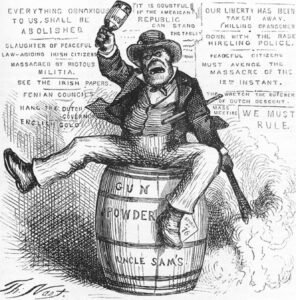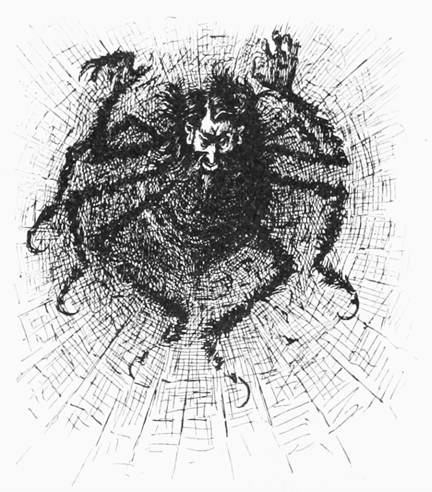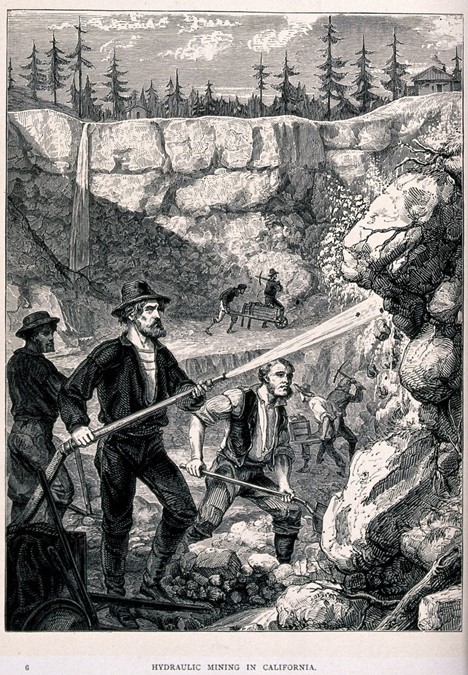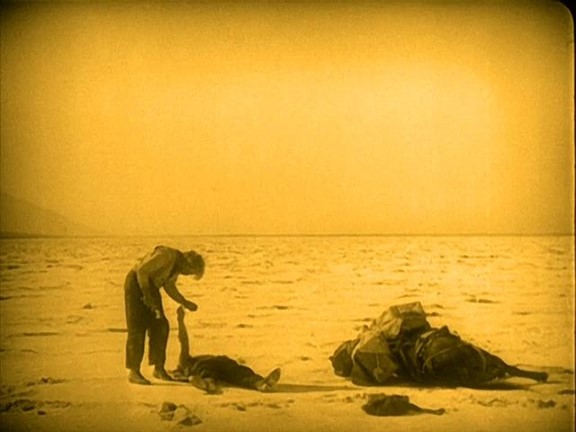7 Racism and Anti-Semitism in the Gilded Age
Racism and Anti-Semitism in the Gilded Age
As we noted in our short discussion of Norris’s professor Joseph Le Conte, European immigrants were considered by many educated Americans to be of lesser stock than “Anglo-Saxon” whites. Norris frequently draws attention to his characters’ ethnic attributes: there is the Swiss-German Trina, of whom we learn that “a good deal of peasant blood still ran undiluted in her veins”; there are the Heises, with their exaggerated accents; and of course there is McTeague, who evokes many nineteenth-century stereotypes about the Irish. He is described as unintelligent, strong, and reliable as a “draught-horse,” until drinking awakens his inner “ape.”The perception of the Irish as apelike and unfit for civic life had its roots in England and was rooted in anti-Catholic prejudice. McTeague’s parents could have been among the thousands of Irish immigrants who came to the U.S. in the 1840s and 1850s, fleeing a devastating potato famine in their home country. Many travelled west in the hope of striking it rich in the California Gold Rush; by 1880, thirty-seven percent of San Franciscans were of Irish ancestry (Dawson 40). There was also a widespread stigma against Mexicans, many of whom came to the western U.S. to work as farmers and ranchers. (Many ethnic Mexicans were not migrants at all; large expanses of California, New Mexico, and Texas were part of Mexico until 1848.) As the Chicano (Mexican American) literary scholar Lee Bebout writes, “From the early nineteenth century to the present day, the Mexican Other has been figured through tropes of the Infernal Paradise; the Violent, Savage Mexican; the Lawless Mexican; the Erotic, Exotic Mexicana; the Nonindustrious Mexican; the Mexican Invasion; and others” (ch. 1). How many of those tropes does Maria Macapa embody? Does she depart from those stereotypes in any way?

The most pronounced racial prejudice in McTeague is anti-Semitism. In the nineteenth century, being Jewish was thought of as a racial identity rather than a religion. Ashkenazi (eastern European) Jews were considered to be of mixed European and “Asiatic” origin. There are some important differences between anti-Semitism and other forms of racism. Whereas many forms of racism present non-Anglo-Saxons as unintelligent, anti-Semitic representations depict Jews as highly intelligent. But that intelligence is cast in a sinister light, as a talent for scheming and manipulation. Racist representations of African Americans, Hispanics, and the Irish traditionally emphasize their subjects’ poverty or dependency on charity and welfare. Anti-Semitism, by contrast, often makes Jews out to be excessively wealthy, the result of greed, penny-pinching, trickery, or conspiracy.
The shopkeeper Zerkow encapsulates several centuries’ worth of anti-Semitic stereotypes. Greed seems to have contorted his physical form: he has “claw-like, prehensile figures” and the “thin, eager, cat-like lips of the covetous” (ch. 3). Sixty years old and surely unappealing, he ensnares Maria through psychological manipulation and eventually with physical violence. And he allows Maria to dominate him, psychologically and erotically. To a reader acquainted with Nordau’s Degeneration, this would be proof that Zerkow is insufficiently masculine and sexually perverse.
Several literary characters have been identified as a possible basis for Zerkow, including Shylock, the Jewish moneylender in William Shakespeare’s The Merchant of Venice (1600), who demands a pound of flesh in exchange for three thousand gold coins; Fagin, fromCharles Dickens’s Oliver Twist (1839), a redhead who entices orphans to steal for him; and Svengali from George Du Maurier’s Trilby (1894). (You may recall Du Maurier as the writer-illustrator who inspired Henry James’s “The Real Thing.”) Svengali hypnotizes a woman and makes her a talented singer, but only while she is under his trance. Like Zerkow, Svengali was given demonic, claw-like hands. Biographers know that Norris saw a theatrical adaptation of Trilby in 1895, while he was working on the first draft of McTeague (Pizer, American Naturalism and the Jews 25). They do not know, however, whether he consciously modelled Zerkow on Svengali, or any other character.

Patrick Collins
Note
Before beginning this section, you should have read to the end of chapter 19. It will be a “spoiler” if you haven’t.
One of the inspirations for McTeague was the trial of Patrick Collins for the murder of his estranged wife. Collins was a former ironworker who drank heavily and struggled to find regular work. After an escalating period of abuse, his wife, Sarah, left him and took their children with her. When Sarah stopped giving Collins money, Collins stabbed her to death in the kindergarten classroom where she was working as cleaner.
The connection between the Collins case and McTeague should be obvious. Nonetheless, we encourage you to read the newspaper article “He Was Born for the Rope,” from the October 14, 1893 issue of the San Francisco Examiner. Take note of the way the reporter describes the case, using the language of degeneration and innate criminality to describe Patrick Collins and seeming to blame Sarah Collins for her own murder.
Gold and the California Gold Rush
Note
Before beginning this section, you should have read to the end of chapter 22.
Trina is in dire straits. She has lost a friend, a husband, and three fingers. So, she withdraws some of her money from her savings vault. That much is reasonable. But what she does with it is not.
Trina cashed the check and returned home with the money—all in twenty-dollar pieces as she had desired—in an ecstasy of delight. For half of that night she sat up playing with her money, counting it and recounting it, polishing the duller pieces until they shone. Altogether there were twenty twenty-dollar gold pieces.
‘Oh-h, you beauties!’ murmured Trina, running her palms over them, fairly quivering with pleasure. ‘You beauties! Is there anything prettier than a twenty-dollar gold piece? You dear, dear money! Oh, don’t I love you! Mine, mine, mine—all of you mine.’ (ch. 19)
Eventually, she withdraws her entire fortune and takes it to bed. Trina’s hoarding defies economic logic. The “rainy day” she claimed to be saving for has surely arrived, but she is not spending the money. Nor is she collecting interest by keeping it in Uncle Oelbermann’s vault.
Critics have written extensively about Trina’s perverse relation to wealth. Walter Benn Michaels argues that Trina’s “simultaneous desire to own and to be owned” is a natural, if extreme, response to capitalism (“Masochism, Money, and McTeague” 8). Jennifer Fleissner reads Trina’s hoarding as her way of resisting a “gender system that understands women as possessing a value inevitably to be lost” (228).
Since the 1860s, paper money (sometimes called “greenbacks”) had come to supplant gold for most transactions. But many Americans were unconvinced that paper was a reliable currency. Trina “would look at the paper that Uncle Oelbermann had given her, and tell herself that it represented five thousand dollars. But in the end this ceased to satisfy her, she must have the money itself” (ch. 19, quoted in Michaels, “The Gold Standard and the Logic of Naturalism” 110). Of course, gold has no more intrinsic value than paper. Does the metal in Trina’s bank account have the same value as the metal in her tooth? As the ore in the ground?

Take note of the way Norris’s writing style changes when the setting shifts to Iowa Hill, a mining town about 250 kilometres inland from San Francisco. Up to this point, the characters have been squeezed into tight spaces, both physically and psychically. But now it seems that the world is opening up in all directions, and the incessant human activity can finally stop. “A tremendous, immeasurable Life pushed steadily heavenward without a sound, without a motion” (ch. 20). These final chapters contain some of Norris’s most striking, lyrical passages, proving him to be a true literary artist in spite of his dismissive remarks about style in the essays you read earlier.
Norris wrote these final chapters near the Big Dipper gold mine in Placer County. He had been going through a period of nervous exhaustion, and credited the “outdoor life” with restoring his strength to finish the book (Lutz 144). This is another example of the “back to nature” ideology of late nineteenth-century America, from Jack London’s Call of the Wild to Theodore
Roosevelt’s speeches in praise of hunting and the “strenuous life,” to the emergent Boy Scouts of America movement.
The “nature” said to restore men’s natural vigour was often personified as a woman. “In some places east of the Mississippi,” the narrator explains, “nature is cosy, intimate, small, and homelike, like a good-natured housewife.” But “in Placer County, California, she is a vast, unconquered brute of the Pliocene epoch, savage, sullen, and magnificently indifferent to man.” The miners who try to possess “her” are compared to lice, vampires, and dentists.
Norris was not alone in equating the extraction of raw materials with violent or unnatural sexuality, as the literary theorist Mark Seltzer notes:
Norris’s representation of mining [was not] at all anomalous in this period. In his popular history of California, The Sunset Land (1870), the Reverend John Todd, a minister who also wrote student manuals governing sexual behaviour, contrasts mining, which he calls the ‘unnatural creation of property’ to the more natural creations of agriculture. He notes as well that the eagerness of newly arrived California gold-seekers was so great that ‘infants were turned out of cradles, that the cradles might be used for washing gold.’ Todd may be confusing the miner’s sieve, called a cradle, with the infant’s cradle, but the confusion itself is perhaps significant…. Such a confusion is perhaps shared by Norris’s Trina McTeague, for instance, who weeps over the empty bag and box that had contained her gold coins ‘as other women weep over a dead baby’s shoe’ [ch. 19]. Todd, among others, frequently sees the extraction of wealth from the ‘bosom of mother earth’ as a counter-image of procreation, and indeed contraposes such male ‘unnatural’ creation to a threatening female generativity. (34)
For Americans, the western frontier had long been a site of national ambitions, promising wealth and “perennial rebirth” (as the historian Frederick Jackson Turner put it in 1893). But westward expansion required the violent displacement of Native Americans. The indigenous population of California declined from about 150,000 in the late 1840s to under 20,000 by 1880 (Locke and Wright, ch. 17, sec. 4). McTeague’s brief meeting with a broken-down “Indian buck” (a racial slur) is the novel’s only glimpse of this history. Under 1850s laws, white Californians could force Native Americans into “apprenticeships,” with no pay, for up to twenty years. Big Jim may be an indentured mine worker whose employer abandoned him. In the depiction of Jim as a “solitary point of red, lost in the immensity of the surrounding white blur” (ch. 21), Norris is voicing a social-Darwinist belief that indigenous people were a relic of the past. But he is also describing McTeague.

The “brute” McTeague is no match for the “brute” that is Death Valley, the hottest, driest, and lowest region in the U.S. In August 2018, Death Valley had the hottest month in the history of earth—an average of 108° F, or about 42° C (“Death Valley Rises”). Although Norris would not have thought of it in such terms, McTeague is a novel of ecological catastrophe. McTeague dies with a sack full of gold and not a drop of water to drink, as the canary chirps out its final notes of warning.

